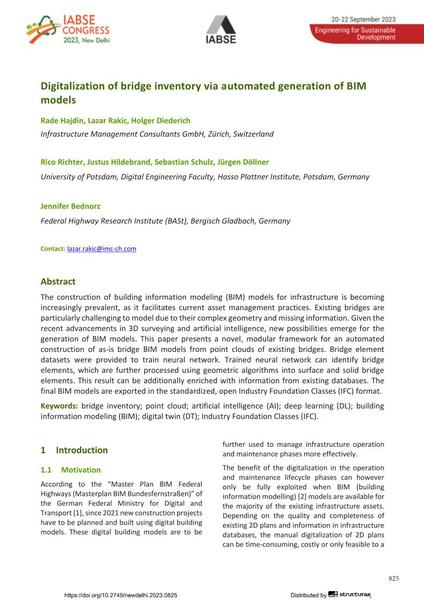Digitalization of bridge inventory via automated generation of BIM models

|
|
|||||||||||
Détails bibliographiques
| Auteur(s): |
Rade Hajdin
(Infrastructure Management Consultants GmbH, Zurich, Switzerland)
Lazar Rakic (Infrastructure Management Consultants GmbH, Zurich, Switzerland) Holger Diederich (Infrastructure Management Consultants GmbH, Zurich, Switzerland) Rico Richter (University of Potsdam, Digital Engineering Faculty, Hasso Plattner Institute, Potsdam, Germany) Justus Hildebrand (University of Potsdam, Digital Engineering Faculty, Hasso Plattner Institute, Potsdam, Germany) Sebastian Schulz (University of Potsdam, Digital Engineering Faculty, Hasso Plattner Institute, Potsdam, Germany) Jürgen Döllner (University of Potsdam, Digital Engineering Faculty, Hasso Plattner Institute, Potsdam, Germany) Jennifer Bednorz (Federal Highway Research Institute {BASt}, Bergisch Gladbach, Germany) |
||||
|---|---|---|---|---|---|
| Médium: | papier de conférence | ||||
| Langue(s): | anglais | ||||
| Conférence: | IABSE Congress: Engineering for Sustainable Development, New Delhi, India, 20-22 September 2023 | ||||
| Publié dans: | IABSE Congress New Delhi 2023 | ||||
|
|||||
| Page(s): | 825-833 | ||||
| Nombre total de pages (du PDF): | 9 | ||||
| DOI: | 10.2749/newdelhi.2023.0825 | ||||
| Abstrait: |
The construction of building information modeling (BIM} models for infrastructure is becoming increasingly prevalent, as it facilitates current asset management practices. Existing bridges are particularly challenging to model due to their complex geometry and missing information. Given the recent advancements in 3D surveying and artificial intelligence, new possibilities emerge for the generation of BIM models. This paper presents a novel, modular framework for an automated construction of as-is bridge BIM models from point clouds of existing bridges. Bridge element datasets were provided to train neural network. Trained neural network can identify bridge elements, which are further processed using geometric algorithms into surface and solid bridge elements. This result can be additionally enriched with information from existing databases. The final BIM models are exported in the standardized, open Industry Foundation Classes (IFC} format. |
||||
